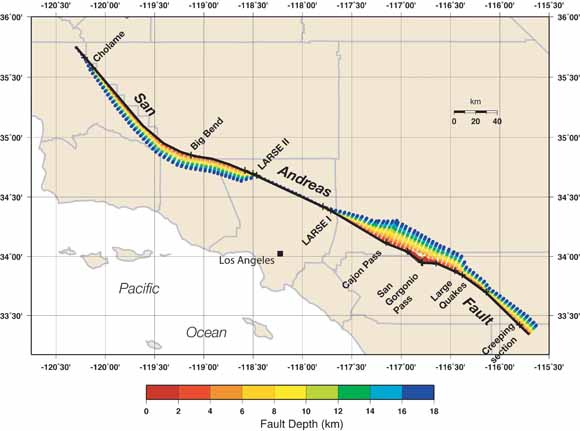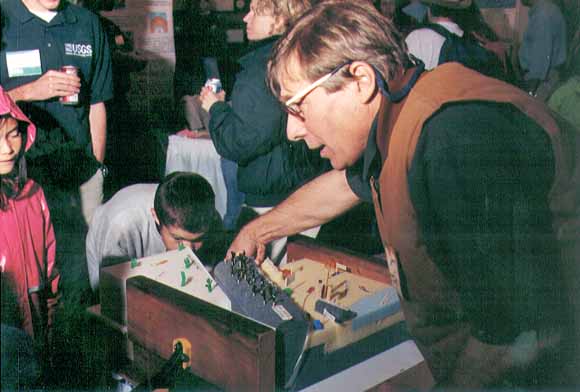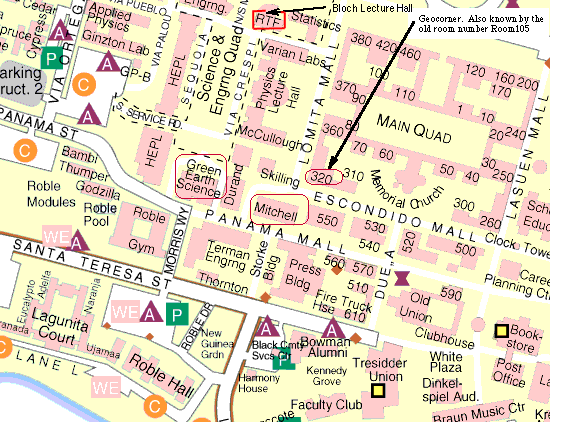
Location: Stanford University
see Map showing Mitchell and GeoCorner Room 320
This will be the 392nd meeting since 1954

The San Andreas Fault (SAF) in southern California is in most places non-vertical, based on seismic-imaging, potential-field, earthquake-aftershock, and selected microseismicity studies of the crust. The dip on the SAF changes from SW (55-75 deg.) near the Big Bend to NE (10-70 deg.) southeastward of the eastern San Gabriel Mountains, describing a crude propeller shape.
A P-wave tomographic image of the mantle in southern California suggests, in cross sections across the SAF, that the plate boundary extends into the mantle with a dip similar to that of the SAF the crust. Mantle velocities southwest of this projected plate boundary, within the Pacific plate, are relatively high and constitute the well documented upper-mantle high-velocity body of the Transverse Ranges. This relationship is similar to that between the Alpine fault of New Zealand and its underlying mantle, and suggests that in both California and New Zealand, Pacific-plate lithospheric mantle is downwelling along the plate boundary.

Born in 1944 in Oak Ridge, Tennessee, Gary Fuis has always loved the out-of-doors and geology."The things that have happened in the past on this Earth and in our solar system are more awe-inspiring than any fiction ever written," he said.
Fuis earned a bachelor of science degree at Cornell University in 1966. After completing his Ph.D. at the California Institute of Technology in 1974, he went to work for the U.S. Geological Survey (USGS), where he has been studying earthquakes ever since. When he first joined USGS, he operated and expanded the USGS/Caltech Southern California seismographic network.
In addition to his most recent work exploring the crustal structure and tectonics of the Los Angeles region, he has performed similar studies along the route of the Alaskan oil pipeline, from the Pacific to the Arctic Oceans. In the 1980s, Fuis also used explosions and a newly developed system of portable seismograph to investigate the crustal structure of the Salton Trough region of Southern California and of the Klamath Mountains and Mount Shasta in northern California.
Reservations: The preferred way to make reservations is simply to email John Spritzer at jspritzer@usgs.gov by November 9, tell him you will attend, commit to pay, and bring your payment to the meeting. John always emails a confirmation; if you don’t get one, assume email crashed yet again and email him a second time. A check made to “PGS” is preferred, payable at the meeting.
If you want to pay in advance:
Everyone (including Stanford folks now) Please make dinner reservations by November 9. Contact John Spritzer, at U.S. Geological Survey, 345 Middlefield Road, MS-973 Menlo Park, CA 94025, Tel.: (650) 329-4833. Send check made out to “PGS” to John.
Dinner is $30.00. Includes wine (5:30 to 6:15 PM.) and dinner (6:15-7:30 PM.).
For students from all universities and colleges, the dinner, including the social 3/4-hour, is $5.00 and is partially subsidized thanks to the School of Earth Sciences, Stanford University (Note, no-show reservations owe the full price).
Doris, whose wonderful crew prepares our meals, asked that we let you know that people who are late RSVPing and people who show up without a reservation will be welcome but that they will be eating on paper plates with plastic utensils (food supply permitting).
Dues for Academic Year 2007-2008 ($10.00) should be sent to John Spritzer, U.S. Geological Survey, 345 Middlefield Road, MS-973 _Menlo Park, CA 94025. John’s phone: (650) 329-4833.
Officers: Tom Moore, President; Keith Howard, Vice President; Mike Diggles, Secretary; John Spritzer, Treasurer; Elizabeth Miller, PGS Stanford University Coordinator

Date created: October 31, 2007
Last modified: November 2, 2007
Created by: Mike Diggles, Webmaster-Secretary, PGS.